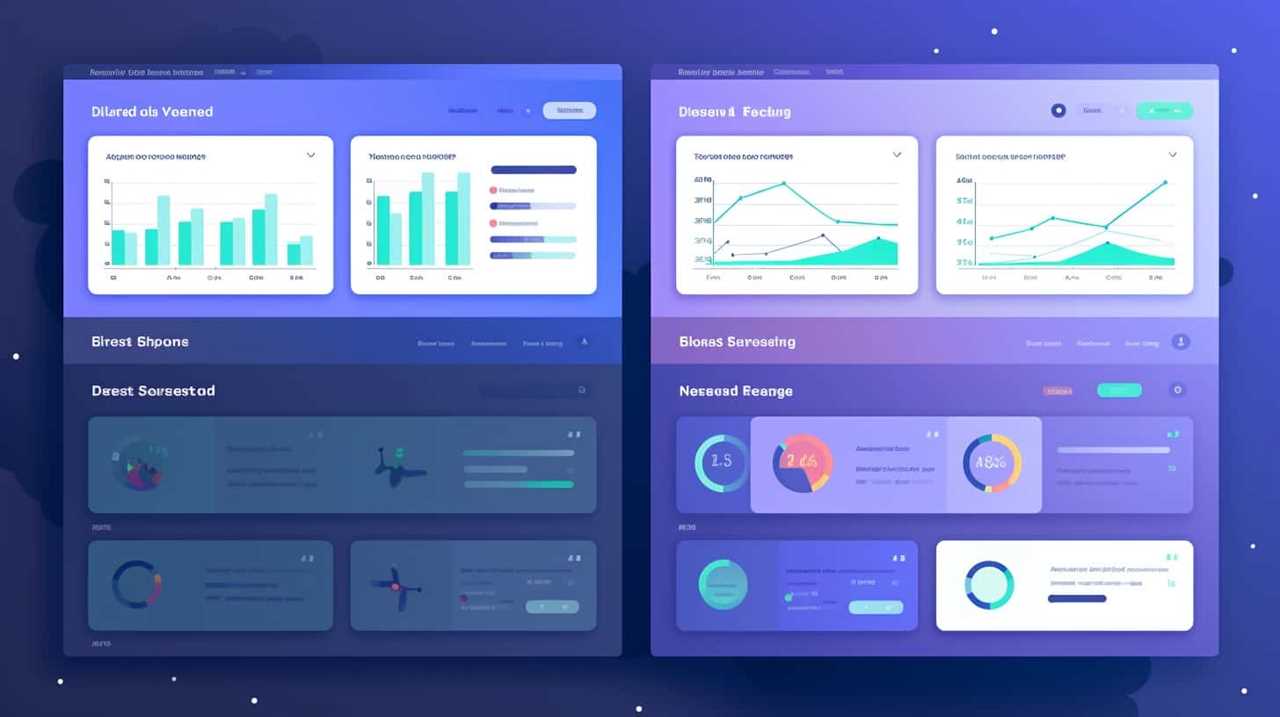Are you ready to delve into the secrets of e-commerce SEO? Brace yourself, because we’re about to reveal the wealth of keyword optimization.
In this article, we’ll dive deep into the 9 best practices that will take your online store to new heights.
From thorough keyword research to leveraging user-generated content, we’ll equip you with the strategies needed to dominate the search engine rankings.
Get ready to master the art of keyword optimization and watch your e-commerce business soar.

It’s time to claim your rightful place at the top.
Key Takeaways
- Thorough keyword research and understanding search intent are crucial for effective keyword optimization in e-commerce SEO.
- Utilizing long-tail keywords provides advantages such as less competition, higher conversion rates, and higher rankings in search engine results pages.
- Optimizing title tags, meta descriptions, and URL structure helps improve search engine visibility and site navigation.
- Crafting compelling product descriptions using emotional language and providing necessary information strategically can connect with the audience on a deeper level.
Conducting Thorough Keyword Research
When conducting thorough keyword research, we must start by understanding the target audience’s search intent. This involves analyzing their motivations, needs, and preferences to ensure that our chosen keywords align with what they’re actively searching for.
One crucial step in this process is performing a competitive analysis to identify the keywords that our competitors are targeting successfully. By understanding their strategies and the keywords they rank for, we can gain valuable insights to inform our own keyword optimization efforts.
Additionally, conducting a keyword density analysis allows us to determine the frequency and prominence of our chosen keywords within our content. This analysis helps us strike the right balance between optimizing for search engines and providing valuable, user-focused content.

Understanding Search Intent
To understand search intent, we analyze the motivations, needs, and preferences of our target audience, ensuring our keywords align with what they actively search for. User behavior plays a crucial role in this analysis, as it provides insights into how people search and what they expect to find.
By understanding user behavior, we can tailor our keyword optimization efforts to match their search patterns and deliver the most relevant content.
Additionally, it’s essential to keep up with the ever-evolving search algorithm. Staying informed about the latest updates and trends allows us to optimize our keywords effectively and improve our website’s visibility in search results.
Utilizing Long-Tail Keywords
When it comes to keyword optimization for e-commerce SEO, utilizing long-tail keywords can be a game-changer. Long-tail keywords offer several advantages, such as lower competition and higher conversion rates.

To effectively utilize long-tail keywords, it’s crucial to conduct thorough research, identify specific user intent, and create targeted content that addresses the needs and interests of your target audience.
Long-Tail Keyword Advantages
By utilizing long-tail keywords, we can gain a competitive advantage in e-commerce SEO. Long-tail keywords, which consist of longer phrases, have several advantages over short-tail keywords. Here are two key benefits of using long-tail keywords:
- Less competition: Long-tail keywords are more specific and targeted, which means they’ve less competition compared to generic keywords. This allows us to rank higher in search engine results pages (SERPs) and attract more qualified traffic to our e-commerce website.
- Higher conversion rates: Long-tail keywords often indicate that the user is looking for something specific, which makes them more likely to convert into customers. By targeting these keywords, we can attract users who are closer to the purchasing stage and increase our conversion rates.
To uncover long-tail keyword opportunities, we can employ various long-tail keyword research techniques, such as analyzing customer search queries, using keyword research tools, and examining competitors’ keyword strategies. By incorporating these techniques into our SEO strategy, we can optimize our e-commerce website for long-tail keywords and maximize our online visibility, traffic, and conversions.
Effective Long-Tail Strategies
We frequently employ effective long-tail strategies to maximize the utilization of long-tail keywords in our e-commerce SEO. Long-tail keywords are essential for driving targeted traffic to our website and increasing our chances of conversion. To achieve this, we utilize advanced long tail keyword tools that help us identify the most relevant and high-converting long-tail keywords for our e-commerce business. These tools enable us to uncover hidden opportunities and insights into long-tail keyword competition, allowing us to optimize our SEO strategies accordingly.

By incorporating long-tail keywords into our website content, product descriptions, and blog posts, we can attract highly motivated and qualified customers who are actively searching for specific products or solutions. This strategic approach not only helps us stand out from our competitors but also improves our search engine rankings and overall visibility.
Now, let’s delve into the next section, where we’ll discuss the importance of optimizing title tags and meta descriptions for effective e-commerce SEO.
Optimizing Title Tags and Meta Descriptions
Optimizing title tags and meta descriptions plays a crucial role in achieving unrivaled keyword optimization for e-commerce SEO. Crafting persuasive copywriting is essential for attracting potential customers and driving organic traffic to your online store. When it comes to meta tags, their importance can’t be overstated. They provide a concise summary of your webpage’s content and act as a preview for search engine users.
To optimize title tags and meta descriptions effectively, consider the following:

- Crafting persuasive copywriting:
- Use compelling language that entices users to click on your website.
- Incorporate relevant keywords naturally to improve search engine visibility.
- Importance of meta tags:
- Ensure your meta tags accurately reflect the content on the webpage.
- Write unique meta tags for each page to maximize keyword targeting.
Creating Unique and Compelling Product Descriptions
Crafting unique and compelling product descriptions is an essential aspect of e-commerce SEO. They continue the persuasive copywriting strategy from the previous subtopic and effectively engage potential customers.
Product storytelling is a powerful technique that allows businesses to connect with their audience on a deeper level. By incorporating emotional language into product descriptions, we can tap into the emotions and desires of customers, making them more likely to make a purchase. Using words that evoke excitement, curiosity, or desire can create a sense of urgency and drive conversions.
Furthermore, these descriptions should be precise and strategic, providing potential customers with the information they need to make an informed buying decision.
Optimizing URL Structure and Internal Linking
When it comes to optimizing URL structure and internal linking, there are a few key points to consider.

First, the length of the URL can impact its visibility and search engine rankings. Shorter URLs tend to perform better, so it’s important to keep them concise and relevant.
Second, anchor text plays a crucial role in internal linking. Using descriptive and keyword-rich anchor text helps search engines understand the content of the linked page.
Lastly, cross-linking can provide numerous benefits, such as improving site navigation and distributing link equity throughout the website.
Short Vs Long URLs
We recommend using short URLs for optimal URL structure and internal linking in e-commerce SEO. Short URLs have several advantages over long URLs in terms of SEO and user experience.

Here are some key points to consider:
- URL optimization techniques:
- Including relevant keywords in the URL helps search engines understand the content of the page.
- Keeping URLs concise and descriptive makes them more user-friendly and easier to remember.
- Short URLs vs long URLs debate:
- Short URLs tend to have higher click-through rates due to their clean and concise appearance.
- Long URLs may contain unnecessary parameters or irrelevant information, which can confuse search engines and users.
Anchor Text Importance
Continuing the optimization of URL structure and internal linking, we emphasize the importance of anchor text in e-commerce SEO. Anchor text refers to the clickable text in a hyperlink, and it plays a crucial role in backlink building and improving search engine rankings. By optimizing anchor text, you can enhance the relevance and visibility of your website to both users and search engines. Here are some best practices for optimizing anchor text for SEO:
| Best Practices for Optimizing Anchor Text for SEO |
|---|
| Use descriptive and keyword-rich anchor text |
| Keep it concise and relevant to the linked page |
| Avoid generic terms and use specific keywords |
| Use a variety of anchor text variations |
| Avoid over-optimization and keyword stuffing |
Cross-Linking Benefits
To optimize URL structure and internal linking, we can maximize the benefits of cross-linking. Cross-linking refers to the practice of linking different pages within a website to create a network of interconnected content. By strategically implementing cross-linking strategies, we can improve the user experience, increase website traffic, and enhance search engine visibility.
Here are two sub-lists that delve deeper into the significance of cross-linking:

- Optimizing URL Structure:
- Use descriptive keywords in the URL for better search engine optimization.
- Ensure that the URL structure is organized and follows a logical hierarchy.
- Internal Linking Best Practices:
- Incorporate relevant anchor text when linking to other pages on the website.
- Create a comprehensive internal linking structure to facilitate easy navigation for users and search engines.
Leveraging User-Generated Content for Keyword Optimization
One effective way to enhance keyword optimization is by harnessing the power of user-generated content. User-generated content refers to any content created by users or customers, such as reviews, comments, and social media posts.
Leveraging user-generated content can provide numerous benefits for SEO. Firstly, it adds credibility and authenticity to your website, as users trust the opinions and experiences of fellow consumers. This can increase engagement, time spent on site, and ultimately improve your search engine rankings.
Secondly, user-generated content provides a wealth of keywords and long-tail phrases that your target audience is using to search for products or services. By analyzing user-generated content, you can identify popular search terms and incorporate them into your website’s content strategy.
To harness the full potential of user-generated content, it’s important to implement effective strategies such as encouraging customers to leave reviews, engaging with users on social media, and featuring user-generated content on your website.

Implementing Structured Data Markup for Enhanced Visibility
We implement structured data markup to enhance visibility on our e-commerce website. Structured data implementation, also known as schema markup, offers several benefits that can greatly improve our website’s performance and visibility.
Here are two key reasons why structured data markup is crucial for enhanced visibility:
- Improved Search Engine Results Page (SERP) display:
- Structured data markup provides search engines with additional context about our website’s content, allowing them to display rich snippets in the search results. These snippets can include ratings, reviews, prices, and other relevant information, attracting more attention and increasing click-through rates.
- By implementing schema markup, we can also optimize our website for voice search, as search engines rely on structured data to provide accurate and relevant information to voice queries.
- Enhanced mobile experience:
- Structured data markup helps search engines understand our website’s mobile-friendliness and responsiveness. This can lead to improved rankings on mobile search results and a better user experience for mobile users.
Monitoring and Adjusting Keyword Strategy for Ongoing Success
As marketers, it is crucial for us to continuously monitor and adjust our keyword strategy to ensure ongoing success in e-commerce SEO. Tracking keyword performance allows us to identify which keywords are driving traffic and conversions, and which ones are falling short. By analyzing metrics such as search volume, click-through rate, and conversion rate, we can make informed decisions about our keyword strategy. Adapting keyword strategy involves optimizing existing content, creating new content, and targeting new keywords that align with our business goals and target audience. We must stay up-to-date with industry trends, competitor analysis, and user behavior to stay ahead of the game. By regularly monitoring and adjusting our keyword strategy, we can maximize our visibility, drive targeted traffic, and ultimately achieve unrivaled success in e-commerce SEO.
| Keyword Performance Metrics | Action Steps |
|---|---|
| Search Volume | Identify high-volume keywords to target. |
| Click-through Rate | Optimize meta titles and descriptions for higher click-through rates. |
| Conversion Rate | Analyze landing page performance and optimize for higher conversions. |
| Competitor Analysis | Research competitor keywords and incorporate them into our strategy. |
| User Behavior | Monitor user behavior on our website and adjust our keyword strategy accordingly. |
Frequently Asked Questions
How Can I Find the Best Tools for Conducting Thorough Keyword Research?
We can find the best tools for conducting thorough keyword research by focusing on top rated keyword research tools for e-commerce optimization and implementing strategies for finding long tail keywords in our industry.

What Are Some Common Mistakes to Avoid When Optimizing Title Tags and Meta Descriptions for E-Commerce Websites?
Common mistakes in optimizing title tags and meta descriptions for e-commerce websites include neglecting the importance of keyword placement. We must strategically position keywords to maximize visibility and drive traffic.
How Can I Encourage Customers to Leave User-Generated Content That Includes Relevant Keywords?
To encourage customers to leave user-generated content with relevant keywords, we can leverage influencer collaboration. By partnering with influencers, we can motivate their followers to create content that includes the desired keywords. Additionally, implementing social media engagement strategies can also incentivize customers to leave content on these platforms.
Are There Any Specific Guidelines to Follow When Implementing Structured Data Markup for Enhanced Visibility?
When implementing structured data markup for enhanced visibility, we follow specific guidelines. We make our e-commerce website stand out by using structured data, optimizing it for better visibility.
What Are Some Effective Ways to Monitor and Adjust Keyword Strategy for Ongoing Success in E-Commerce Seo?
Monitoring and adjusting our keyword strategy is crucial for ongoing success in e-commerce SEO. We employ precise, analytical methods to ensure our keywords are optimized, constantly monitoring and adjusting to stay ahead of the competition.

Conclusion
In conclusion, implementing these best practices for keyword optimization in e-commerce SEO can greatly enhance your online visibility and drive more targeted traffic to your website. By conducting thorough keyword research, understanding search intent, and utilizing long-tail keywords, you can optimize your website’s title tags, meta descriptions, and product descriptions for maximum impact.
Additionally, optimizing URL structure, leveraging user-generated content, implementing structured data markup, and continuously monitoring and adjusting your keyword strategy will ensure ongoing success.
So, are you ready to take your e-commerce SEO to new heights?










